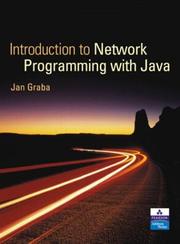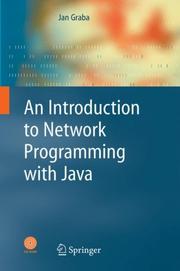| Listing 1 - 3 of 3 |
Sort by
|
Book
ISBN: 1447152530 1447152549 Year: 2013 Publisher: London : Springer London : Imprint: Springer,
Abstract | Keywords | Export | Availability | Bookmark
 Loading...
Loading...Choose an application
- Reference Manager
- EndNote
- RefWorks (Direct export to RefWorks)
Since the second edition of this text, the use of the Internet and networks generally has continued to expand at a phenomenal rate. This has led to both an increase in demand for network software and to improvements in the technology used to run such networks, with the latter naturally leading to changes in the former. During this time, the Java libraries have been updated to keep up with the new developments in network technology, so that the Java programming language continues to be one of the mainstays of network software development. In providing a very readable text that avoids getting immersed in low-level technical details, while still providing a useful, practical guide to network programming for both undergraduates and busy IT professionals, this third edition continues the trend of its predecessors. To retain its currency, the text has been updated to reflect changes that have taken place in Java's network technology over the past seven years (including the release of Java 7), whilst retaining its notable features of numerous code examples, screenshots and end-of-chapter exercises.
Computer Communication Networks. --- Computer science. --- Data transmission systems. --- Software engineering. --- Electrical & Computer Engineering --- Engineering & Applied Sciences --- Telecommunications --- Input-output equipment (Computers). --- Computer communication systems. --- Computer programming. --- Computer Science. --- Input/Output and Data Communications. --- Software Engineering/Programming and Operating Systems. --- Programming Techniques. --- Computers --- Electronic computer programming --- Electronic data processing --- Electronic digital computers --- Programming (Electronic computers) --- Coding theory --- Computer software engineering --- Engineering --- Communication systems, Computer --- Computer communication systems --- Data networks, Computer --- ECNs (Electronic communication networks) --- Electronic communication networks --- Networks, Computer --- Teleprocessing networks --- Data transmission systems --- Digital communications --- Electronic systems --- Information networks --- Telecommunication --- Cyberinfrastructure --- Network computers --- Computer hardware --- Computer I/O equipment --- Electronic analog computers --- Hardware, Computer --- I/O equipment (Computers) --- Input equipment (Computers) --- Input-output equipment (Computers) --- Output equipment (Computers) --- Computer systems --- Informatics --- Science --- Programming --- Distributed processing --- Input-output equipment --- Data communication systems --- Transmission of data --- Information theory --- Telecommunication systems --- Java (Computer program language)

ISBN: 0321116143 Year: 2003 Publisher: Harlow Pearson Addison Wesley
Abstract | Keywords | Export | Availability | Bookmark
 Loading...
Loading...Choose an application
- Reference Manager
- EndNote
- RefWorks (Direct export to RefWorks)
With the growth of the Internet and the increasing use of intranets across a broad spectrum of business areas, there has been a correspondingly large growth of interest in network programming, particularly in the use of client-server applications. Java's inbuilt network programming capabilities and its platform independence have made it a natural choice for network applications and it has, quite rightly, been referred to as 'the language of the internet'. Exceptionally difficult and fraught with pitfalls in most languages, the programming of network applications is greatly eased by the use of the Java libraries. An Introduction to Network Programming with Java provides clear and practical guidance on all the essential aspects of network programming with Java, including the use of sockets, JDBC, servlets, JavaBeans, applets and JavaServer Pages (JSPs). The aim is to enable both students and professional programmers to pick up these vital skills as rapidly as possible, by providing clearly-worded explanations accompanied by short example programs that avoid the inclusion of extraneous code and concentrate upon the relevant concepts.
Internet programming. --- Java (Computer program language). --- Java (programmeertaal). --- Internet programming --- Java (Computer program language) --- java --- netwerk --- netwerkarchitectuur --- 681.3*D32 --- 681.3*D32 language classifications: applicative languages; data-flow languages; design languages; extensible languages; macro and assembly languages; nonprocedural languages; specialized application and very high-level languages (Programminglanguages) --- language classifications: applicative languages; data-flow languages; design languages; extensible languages; macro and assembly languages; nonprocedural languages; specialized application and very high-level languages (Programminglanguages) --- Object-oriented programming languages --- JavaSpaces technology --- Computer programming --- Contains audio-visual material

ISBN: 9781846283802 1846283809 9781846286308 1846286301 Year: 2007 Publisher: London Jan Graba
Abstract | Keywords | Export | Availability | Bookmark
 Loading...
Loading...Choose an application
- Reference Manager
- EndNote
- RefWorks (Direct export to RefWorks)
The continually expanding popularity of both the Internet and local intranets means that the ability to construct reliable network software is a vital skill for many of today's programmers. At the same time, Java's comprehensive libraries of readily-accessible network programming features ensure that Java remains at the forefront of network software development. The first edition of An Introduction to Network Programming with Java provided a 'streamlined' work that could serve equally well as the core text on an undergraduate module and as the quick, clear, 'no-nonsense' guide required by a busy IT professional. Notable amongst its features were its numerous code examples, screenshots and end-of-chapter exercises. The second edition retains these features, but builds upon the success of the original text by introducing the following changes and additions: • Language changes throughout the examples (and the model solutions on the Web site), largely reflecting the significant changes introduced by J2SE 5.0; • Comprehensive update of support software, particularly that used for Web applications; • New material, such as non-blocking servers and the use of the DataSource interface and Data Access Objects (DAOs) for connecting to remote databases; Jan Graba is a Senior Lecturer in Software Engineering at Sheffield Hallam University, where he has specialised in the teaching of network programming with Java for the past five years.
Java (programmeertaal) --- Java (Computer program language) --- Computer networks. --- Internet programming. --- Java (Langage de programmation) --- Réseaux d'ordinateurs --- Programmation sur Internet --- 681.3*D32 --- language classifications: applicative languages; data-flow languages; design languages; extensible languages; macro and assembly languages; nonprocedural languages; specialized application and very high-level languages (Programminglanguages) --- 681.3*D32 language classifications: applicative languages; data-flow languages; design languages; extensible languages; macro and assembly languages; nonprocedural languages; specialized application and very high-level languages (Programminglanguages) --- Computer networks --- Internet programming --- Object-oriented programming languages --- JavaSpaces technology --- Computer programming --- Communication systems, Computer --- Computer communication systems --- Data networks, Computer --- ECNs (Electronic communication networks) --- Electronic communication networks --- Networks, Computer --- Teleprocessing networks --- Data transmission systems --- Digital communications --- Electronic systems --- Information networks --- Telecommunication --- Cyberinfrastructure --- Electronic data processing --- Network computers --- Distributed processing --- Information Technology --- Computer Science (Hardware & Networks) --- Computer science. --- Computer Communication Networks. --- Data transmission systems. --- Software engineering. --- Programming Techniques. --- Input/Output and Data Communications. --- Software Engineering/Programming and Operating Systems. --- Software Engineering. --- Programming Languages, Compilers, Interpreters. --- Computer software engineering --- Engineering --- Data communication systems --- Transmission of data --- Information theory --- Telecommunication systems --- Informatics --- Science --- Computer programming. --- Computer communication systems. --- Input-output equipment (Computers). --- Programming languages (Electronic computers). --- Computer languages --- Computer program languages --- Computer programming languages --- Machine language --- Languages, Artificial --- Computer hardware --- Computer I/O equipment --- Computers --- Electronic analog computers --- Electronic digital computers --- Hardware, Computer --- I/O equipment (Computers) --- Input equipment (Computers) --- Input-output equipment (Computers) --- Output equipment (Computers) --- Computer systems --- Electronic computer programming --- Programming (Electronic computers) --- Coding theory --- Input-output equipment --- Programming
| Listing 1 - 3 of 3 |
Sort by
|

 Search
Search Feedback
Feedback About UniCat
About UniCat  Help
Help News
News